Nutrients Intake and Hypertension
A special issue of Nutrients (ISSN 2072-6643).
Deadline for manuscript submissions: closed (31 May 2019) | Viewed by 156772
Special Issue Editor
Special Issue Information
Dear Colleagues,
Hypertension is a major health problem worldwide, increasing cardiovascular (CV) risk and mortality.
Together with pharmacological treatments, non-pharmacological approaches, such as nutrient intake modifications, play a very important role in optimizing treatment.
A link has been shown between hypertension and body weight, as well as dietary habits.
The aim of this Special Issue is to improve the acknowledgment of the relationships between some nutrients and hypertension, and, moreover, the effects of different dietary approaches on hypertension regulation from different points of view.
Potential topics may include:
- Weight loss and Hypertension
- Mediterranean diet and Hypertension
- Aminoacids and Hypertension
- Protein Intake and Hypertension in CKD patients
- Salt Intake and Hypertension
Assoc. Prof. Francesco Fantin
Guest Editor
Manuscript Submission Information
Manuscripts should be submitted online at www.mdpi.com by registering and logging in to this website. Once you are registered, click here to go to the submission form. Manuscripts can be submitted until the deadline. All submissions that pass pre-check are peer-reviewed. Accepted papers will be published continuously in the journal (as soon as accepted) and will be listed together on the special issue website. Research articles, review articles as well as short communications are invited. For planned papers, a title and short abstract (about 100 words) can be sent to the Editorial Office for announcement on this website.
Submitted manuscripts should not have been published previously, nor be under consideration for publication elsewhere (except conference proceedings papers). All manuscripts are thoroughly refereed through a single-blind peer-review process. A guide for authors and other relevant information for submission of manuscripts is available on the Instructions for Authors page. Nutrients is an international peer-reviewed open access semimonthly journal published by MDPI.
Please visit the Instructions for Authors page before submitting a manuscript. The Article Processing Charge (APC) for publication in this open access journal is 2900 CHF (Swiss Francs). Submitted papers should be well formatted and use good English. Authors may use MDPI's English editing service prior to publication or during author revisions.







